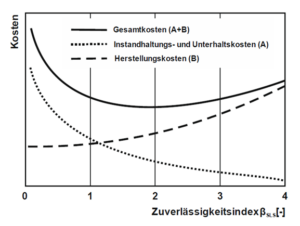Durability of concrete according to the performance-based design -limit states / required reliabilities -.
Contact person: Daniel Cassiani
Concrete is the most used construction material in building and infrastructure construction. In 2018, the German ready-mix concrete industry generated sales of €3.84 billion with production equivalent to 52.7 million cubic meters of ready-mix concrete. Furthermore, the construction and building sector is responsible for (9.95 Gt CO2) of global CO2 emissions. For the sake of saving resources and reducing CO2 emissions, efforts must be made in the selection of construction materials, design, layout, construction logistics, construction methods, maintenance measures and life cycle management.
To be able to guarantee required durability of reinforced and pre-stressed concrete structures, the codes consider only prescriptive design rules so far. To prevent reinforcement corrosion, the standards specify roughly subdivided exposure classes, e.g., regulations and threshold values for the water-cement ratio, the cement type, the cement content and the concrete cover depth. Empirical durability design based on prescriptive design specifications are still practiced today not only in Germany, but in a comparable manner worldwide.
The aim of the project is to identify suitable limit states that economically distinguish an unwanted from a wanted component state regarding durability. For this purpose, it is necessary to determine, with the help of many already performed and documented repair measures, which repair costs were incurred when repairing damaged structures with varying degrees of reliability. It is also necessary to clarify how the service life of a reinforced concrete structure can be predicted until structural damage, for example marked by corrosion-induced cracking, occurs. With the help of extensive data/experience (repair projects already carried out) it is to be clarified at which extent of damage which repair measures are ordered and thus which costs are caused. What are undesirable limit states for the operators of large building stocks for what objective reason? In this way, modelling, adequate limit states and the reliability required for them can be objectively brought together from a technical/economic point of view.
The aim is to perform a life cycle costs assessment of new alternatives for increasing the durability of reinforced concrete against steel corrosion. These new alternatives combine the usage of new materials (such as low binder cements) and other methods (such as increasing concrete cover). With this information, the relationship between cost and durability performance of the elements will be analysed. Furthermore, the work includes the construction of a multi-physics model for forecasting the cracking/spalling damage due to reinforcement corrosion. This information will be used to evaluate the suitability of these two parameters as new limit states for durability assessment. The project is done in partnership with the Technical University of Munich (TUM) and is part of a larger joint research project coordinated by the Deutsche Ausschuss für Stahlbeton (DAfStb).

Letzte Änderung: 11. April 2022